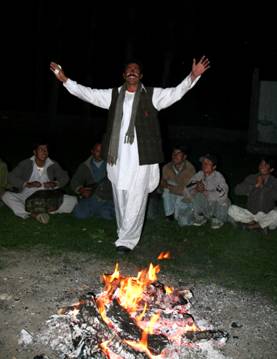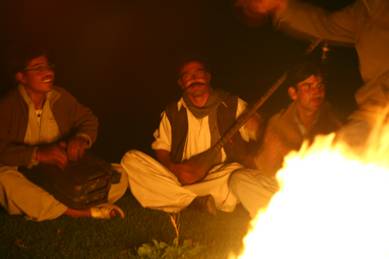Thursday August 14: Tarashing.
A very decent night’s sleep was had. It’s amazing what you can do in the way of toilette and ablutions with just Wet Wipes, a tube of antiseptic hand cleaner gel, and a tap of running cold water! It is possible to get the impression that I am moaning about the accommodation, but that would in fact be the opposite of the truth. In order to see some parts of the world you need to ‘rough-it’ a bit, and in staying at a place like Tarashing (and later in the Kalash valleys) you get much closer to the people and to their way of life, and so you gain so much more from the trip. I repeat my mantra, namely that a hotel really only needs to be clean, comfortable and quiet, and by taking sleeping bags (and in my case my own Tempur travel pillow!!!), you solve the problem if ‘iffy’ bedclothes.
By now we had gotten into the habit of having chapattis with jam for breakfast as it was abundantly clear that warm bread is not the same as toast, and we had noticed that some of the bread had had a little mould around the edges – chapattis are all made freshly. Hilary had porridge, the consistency of which varied considerably from place to place, though she always ate it up and pronounced it “excellent”. In my view any food that half the eaters put salt onto and the other half put sugar onto has to be deeply suspect.
 After breakfast
we all walked up to the top of the glacial lateral moraine to get a view of the
glacier and Nanga Parbit; at this altitude, walking uphill is very hard work.
It is very difficult to differentiate the glacier from the valley floor as the
glacier is both full of moraine and is totally rock covered. However, the
lateral moraines are spectacular, rising a couple of hundred feet above the
level of the glacier and the surrounding land – it is geography/geology writ
large and laid out before you. The track up and over the moraines and the
glacier is a well trodden path to the nearby village of Rattu. There were lots
of villagers walking the path, together with donkeys carrying firewood. It is a
good three hour walk to Rattu and the same on the return.
After breakfast
we all walked up to the top of the glacial lateral moraine to get a view of the
glacier and Nanga Parbit; at this altitude, walking uphill is very hard work.
It is very difficult to differentiate the glacier from the valley floor as the
glacier is both full of moraine and is totally rock covered. However, the
lateral moraines are spectacular, rising a couple of hundred feet above the
level of the glacier and the surrounding land – it is geography/geology writ
large and laid out before you. The track up and over the moraines and the
glacier is a well trodden path to the nearby village of Rattu. There were lots
of villagers walking the path, together with donkeys carrying firewood. It is a
good three hour walk to Rattu and the same on the return.
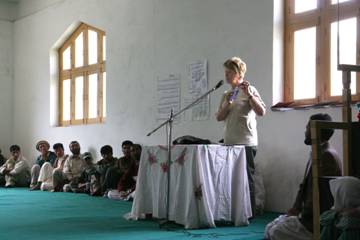
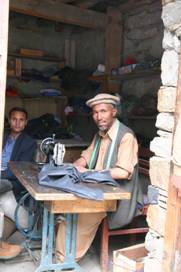 August 14th
is Pakistan Independence Day, and before lunch we went to the Mosque school
which is the school the children go to if they cannot afford even the small
fees for the local public school, and which was holding its prize-giving day.
There were about 60 boys there, plus a dozen girls sitting separately. Around
the edge of the mosque/schoolroom were lots of dads, no mums! We sat and
listened to/watched the prize-giving, after which Margaret gave a small speech
about the importance of education which was greeted with much applause, and we
presented the school with an atlas and some pencils and ball-pens which were
thankfully received.
August 14th
is Pakistan Independence Day, and before lunch we went to the Mosque school
which is the school the children go to if they cannot afford even the small
fees for the local public school, and which was holding its prize-giving day.
There were about 60 boys there, plus a dozen girls sitting separately. Around
the edge of the mosque/schoolroom were lots of dads, no mums! We sat and
listened to/watched the prize-giving, after which Margaret gave a small speech
about the importance of education which was greeted with much applause, and we
presented the school with an atlas and some pencils and ball-pens which were
thankfully received.
After lunch Ehsan had organised for one of the lads (he was about seven) to give us a guided tour of the village. Many of the people in the village are clearly very poor. In one field there was a group of five women cutting hay – squatting on their haunches and using a small hand-held scythe; they seemed to be supervised by a man, but his real role or relationship to the harvesters was not clear. Tarashing, like all Pakistani villages has quite a few shops, most of which seem to be operated on a part-time basis and mostly seem to sell the same or very similar items. One shop however was the village tailor’s and we watched him making a shalwar kamise. Between the five of us we gave the lad 200 rupees which I suspect represented a small fortune to him, but was only about 30pence to each of us!
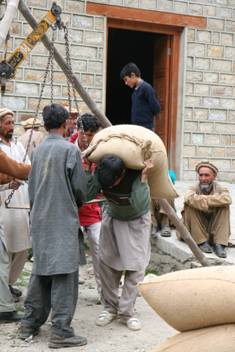
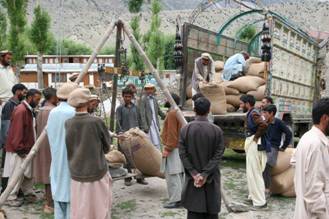 Later in the
afternoon a lorry with some of the winter wheat delivery turned up – it was
seriously heavily loaded and it cannot have been easy to drive up the track.
The wheat was in 100kg sacks, and these were unloaded (manually) so that they
could be weighed. The scales consisted of a large beam balance, with the sack
of wheat placed on one end and the weights on the other. Most of the weights
consisted of two large rocks, the weight of which was presumably agreed by all
parties, which were then topped up by real weights; fine tuning was achieved by
adding an empty sack either to the weights or to the sack of wheat. The agreed
weight was then entered into a ledger and the sacks were placed into a series
of piles - one pile for each family group. I don’t know many people who could
hump a 100kg weight on their backs, let alone at 10,000ft. The wheat was one of
the deliveries for the winter.
Later in the
afternoon a lorry with some of the winter wheat delivery turned up – it was
seriously heavily loaded and it cannot have been easy to drive up the track.
The wheat was in 100kg sacks, and these were unloaded (manually) so that they
could be weighed. The scales consisted of a large beam balance, with the sack
of wheat placed on one end and the weights on the other. Most of the weights
consisted of two large rocks, the weight of which was presumably agreed by all
parties, which were then topped up by real weights; fine tuning was achieved by
adding an empty sack either to the weights or to the sack of wheat. The agreed
weight was then entered into a ledger and the sacks were placed into a series
of piles - one pile for each family group. I don’t know many people who could
hump a 100kg weight on their backs, let alone at 10,000ft. The wheat was one of
the deliveries for the winter.
For dinner we had curried chicken, vegetables, rice and dahl.
A bowl of chicken curry in Pakistan has to be seen to be believed. For a start, the chicken will almost certainly be ‘free range’, that is to say it will have had to eek out a living on virtually nothing (no supplementary food here), and so will inevitably be incredibly scrawny and tough. There will certainly be more bone than meat, and serious sucking of the bones is required to get any meat at all. A mutton curry is an equally interesting experience, as again, all the meat will be ‘on the bone’ and again there will be a lot more bone than meat. Both the chicken and the mutton are likely to be tough; essentially for the same reason! Don’t think that you avoid the ‘bone’ issue, if you have a biryani. We do get rather spoilt by our tender, ‘off the bone’ curries in the West. If you are used to Indian Restaurants in the UK (nearly all of which are actually run and staffed by Bangladeshis), they make curries a lot hotter than the ones you get in Pakistan; the milder curries we had in Pakistan were no bad thing in this respect. What the above means is that you eat a lot less meat than you normally would, which again is by no means necessarily a bad thing. It also does not do to enquire too closely where the cooking water comes from (the Kalash guest house for example). Pretty much all the food we had though was tasty, and everywhere the food was cooked freshly for us, severely reducing the chances of food poisoning; in fact apart from a 40 hour period when I had a ‘bit of the runs’, neither of us got ill.
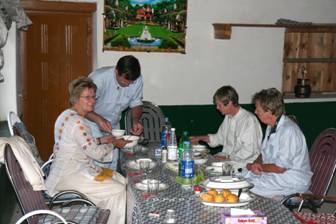 After
dinner Ehsan set up a bonfire of Juniper wood in the back garden, and a couple
of local musicians came to play; one had a long-necked Pakistani guitar, whilst
the other had a drum which was actually an improvised metal petrol can. Very
soon about a couple of dozen locals (men) turned up and sat around the bonfire,
and took their turns doing local dances. Ehsan swore that the arrival of the
locals was completely unscripted, and I’d believe him. It was all great fun for
an hour and a half until the fire burned too low and it became dark and quite
cold.
After
dinner Ehsan set up a bonfire of Juniper wood in the back garden, and a couple
of local musicians came to play; one had a long-necked Pakistani guitar, whilst
the other had a drum which was actually an improvised metal petrol can. Very
soon about a couple of dozen locals (men) turned up and sat around the bonfire,
and took their turns doing local dances. Ehsan swore that the arrival of the
locals was completely unscripted, and I’d believe him. It was all great fun for
an hour and a half until the fire burned too low and it became dark and quite
cold.
